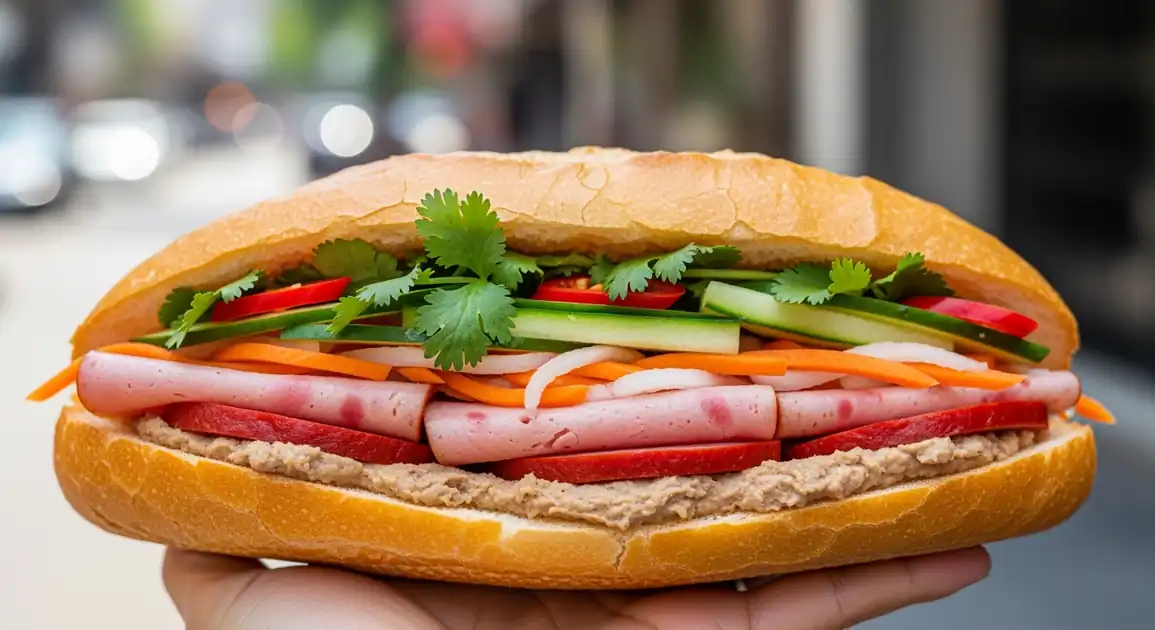Bánh mì (Vietnamese Baguette Sandwich)
Bánh mì

Description
Bánh mì is a national culinary icon in Vietnam, found on nearly every street corner across the country. While universally loved, distinct regional styles exist, reflecting local tastes in fillings, bread texture, and sauces from North to South.
Dietary Information
Serving information
Serving style
Typically served wrapped tightly in paper (often recycled notebook paper or plain paper) or a small plastic bag. Sometimes cut in half for easier handling. Usually eaten immediately by hand.
Quick facts
Highly variable. Many start early (6 AM) for breakfast crowds, others focus on afternoon/evening (3 PM - late). Some operate almost 24/7 in major cities.
Safety Tips
What to Look For
-
Fresh, crispy baguette
Bread should be light with a crisp crust, not stale or chewy. Often kept warm or toasted quickly before assembly.
-
Clean preparation area and utensils
Look for clean cutting boards (separate for meat/veg ideally), knives, and vendor hands/gloves. Avoid vendors with visibly dirty setups.
-
Fresh-looking pickles (đồ chua) and herbs (cilantro)
Pickles should be brightly colored and crisp, herbs should be vibrant green and unwilted. Indicates fresh ingredients.
-
High customer turnover
Busy stalls mean ingredients are used quickly and replenished often, reducing the time fillings sit out.
-
Proper handling of ingredients
Vendor uses tongs, gloves, or clean hands, avoids cross-contaminating ingredients (e.g., touching money then food).
-
Pâté and mayo look fresh
Observe the texture and color; avoid if they look discolored, dried out, or stored improperly in heat.
What to avoid
-
Stale or soft bread
Significantly detracts from the Bánh mì experience and may indicate the vendor isn't focused on quality.
-
Wilted herbs or dull-looking pickles
Suggests ingredients are not fresh, impacting flavor and potentially safety.
-
Fillings left uncovered and exposed for long periods
Increases risk of contamination from dust, insects, and bacterial growth, especially for pâté and meats.
-
Visible signs of poor hygiene
Dirty cart, cloths, utensils, or vendor practices (e.g., no handwashing) are red flags.
-
Re-using oil for fried elements (like ốp la)
If getting a Bánh mì with fried elements (like egg), ensure the oil looks reasonably clean.
Price information
Price range
Budget tips
- Street carts offer the lowest prices (15,000-30,000 VND).
- Simple fillings like 'ốp la' (egg) or 'chả lụa' are often cheaper.
- Famous named shops or tourist hotspots usually charge more (35,000-50,000+ VND).
- Look for vendors popular with locals for good value.
Value indicators
- Generous amount of fillings.
- High-quality, fresh bread.
- Flavorful, well-seasoned meats and pâté.
- Balanced combination of ingredients.
- Made fresh to order.
Where to Find This Dish
Street Corners & Sidewalks
Literally everywhere, especially busy intersections and main roads.
Any busy street
Morning, Afternoon, Late Night
Near Markets
High concentration of food vendors, including Bánh mì stalls.
Local markets ('Chợ')
Morning, Afternoon
Outside Schools & Offices
Catering to students and workers during break times.
Universities, Office buildings
Morning, Lunch, Afternoon
Vendor Tips
- Look for vendors specializing in one type (e.g., 'Bánh mì thịt nướng' only) - they often perfect it.
- Observe how ingredients are stored - freshness is key.
- Don't be afraid to try less famous stalls popular with locals.
- Pointing at ingredients is effective if language is a barrier.
How to Order
Regional Variations
-
Bánh mì Đặc biệt (Special Combo)
(Bánh mì Đặc biệt)
The 'house special', typically includes a mix of Vietnamese cold cuts like chả lụa (pork roll), giò thủ (head cheese), ham, along with pâté, pickles, herbs, etc.
-
Bánh mì Thịt Nướng (Grilled Pork)
(Bánh mì Thịt Nướng)
Filled with freshly grilled, often marinated, slices or skewers of pork. Very popular and aromatic.
-
Bánh mì Xíu Mại (Pork Meatball)
(Bánh mì Xíu Mại)
Contains savory pork meatballs, usually simmered in a light tomato sauce, which moistens the bread.
-
Bánh mì Chả Lụa (Pork Roll)
(Bánh mì Chả Lụa / Giò Lụa)
Features slices of smooth, steamed Vietnamese pork sausage (pork roll).
-
Bánh mì Ốp La (Fried Egg)
(Bánh mì Ốp La)
Contains one or more freshly fried eggs, often with runny yolks, sometimes with soy sauce.
-
Bánh mì Gà (Chicken)
(Bánh mì Gà)
Filled with shredded, grilled, or roasted chicken, seasoned in various styles.
-
Bánh mì Chay (Vegetarian)
(Bánh mì Chay)
Excludes meat and pâté, typically filled with tofu, mock meats, mushrooms, shredded taro, or extra vegetables and pickles.
-
Bánh mì Pate (Pâté Only)
(Bánh mì Pate)
A simpler version focusing primarily on the liver pâté spread, often with butter or mayo and basic condiments.
Cultural context
History
The baguette was introduced to Vietnam by the French during the colonial period. Initially, it was eaten simply with butter or pâté. After the French withdrawal in 1954, Vietnamese vendors adapted the sandwich, adding local ingredients like Vietnamese cold cuts (chả lụa), pickled vegetables, herbs, and sauces, transforming it into the Bánh mì we know today. It became an affordable and popular staple food, evolving with distinct regional variations across North, Central, and South Vietnam.
Local significance
Represents a quintessential Vietnamese street food experience and a symbol of culinary fusion. It's an affordable, convenient, and satisfying meal for people from all walks of life.
Eating customs
- Eaten immediately after preparation for best texture.
- Consumed casually, often standing, walking, or perched on a small plastic stool.
- Usually held in one hand, taking bites from one end.
- Pairs well with soy milk ('sữa đậu nành'), iced tea ('trà đá'), or coffee ('cà phê sữa đá').